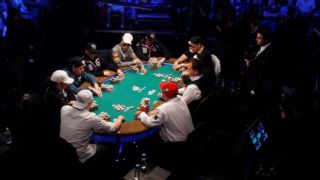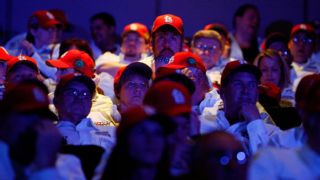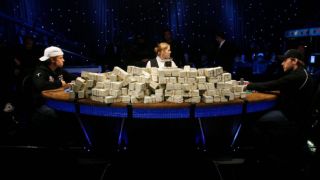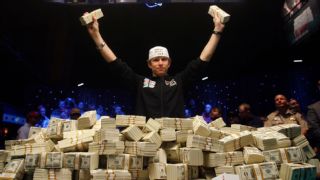|
Fifteen years ago, in May 2003, Chris Moneymaker changed the poker world by capturing the 2003 World Series of Poker main event title. What a lot of people tend to forget, though, is that back in 2003, most people didn't realize that the accountant from Tennessee had captured the WSOP main event title until a couple of months later when ESPN began airing their main event coverage in July. The interest in poker exploded over the next several years as the world became more intrigued by the WSOP main event. Every year, more mainstream outlets reported on the WSOP main event and more poker-dedicated media outlets popped up to report on the action in real time. The internet evolved, and fans had more ways than ever to keep up with the action. Eventually, the poker public was losing its patience with having to wait for the edited television shows to reach the airwaves. In 2007, most poker players already knew that Jerry Yang was crowned champion well before the television coverage aired that fall. Not only did the poker fanatics know who had won the WSOP main event, but they also knew exactly how and what hands were played. That, combined with the first signs of uncertainty in the relationship with online poker following the passing of the UIGEA (Unlawful Internet Gambling Enforcement Act), led to the inevitable decline of the television ratings. To combat this, Harrah's Entertainment (the company that later became Caesars Entertainment in 2010) devised a novel, yet at the time controversial, concept heading into the 2008 WSOP main event -- the November Nine. The WSOP main event would play out as it had before, but the moment it went from 10 players down to nine, they'd halt play on July 14 and wait 117 days. The shows would be produced, fans could watch the action play down and then, on Nov. 9, the final table competitors would reassemble to resume play and battle down to the final two. The following night, those two would play heads-up for the most coveted bracelet in poker. After those two days of play, production crews worked around the clock to get the show ready for broadcast with just a one-day turnaround, with a show that ultimately aired on Nov. 11. The November Nine was the brainchild of Ty Stewart, Executive Director of the WSOP, who thought it would be great to have the poker public wondering: "Who will win?; instead of who had already won." The hope was that this hiatus would create nine new potential poker celebrities, who could do interviews and make appearances over those four months. It also allowed players to sign sponsorship deals with poker and non-poker companies along the way. The alteration was initially met with mixed reviews, as some felt the November Nine would jeopardize the integrity of the game. Others thought the delay could increase the interest in the game. Despite the split feelings, the plan was put into motion. The 2008 WSOP main event began on Thursday, July 3 and a field that eventually reached 6,844 players all had the same goal in mind -- to make that final table.  After a week and half of play, the final 27 players returned to the Rio All-Suite Hotel and Casino on July 14. This would be the day -- 18 players would go home with their hopes dashed, while nine fortunate players would take home a ninth-place payday with their title hopes on hold for the next few months. The immense pressure to make the inaugural November Nine was so intense that some players admitted they did not play optimally due to the stress. "It was very, very intense. People don't realize the pressure when it was getting down to 13 players, 12, 11 and then 10," recalled Dennis Phillips, who carried the chip lead into the final table and ultimately finished in third place. "The table played shorthanded when you had the final two tables, so the blinds were coming around rapidly. The November Nine changed the dynamics of the game drastically." "Yeah, you felt the pressure," added Kelly Kim, who was the short stack entering the November Nine and ended up finishing in 8th place. "The money jump was so big from 10th to 9th ($591,869 to $900,670) and, of course, there was the online poker endorsements. My first goal was to finish in the final nine. So, I definitely didn't play optimally because I was super scared at times as the money got to me." As the final 10 players gathered on the main stage, one more elimination was needed to create the inaugural November Nine. Dean Hamrick was the unfortunate bubble boy after a pair of tough hands; after an initial bad beat, in which his pocket queens lost to Craig Marquis' Ace-Queen via runner-runner heart flush, the Michigan native then ran his own Ace-Jack into Marquis' pocket queens. Reflecting back on that fateful night, Hamrick realized that given the chance to do it all over again, he may have waited for Kim to potentially bust out. "I didn't pay attention to how short Kelly was. I was more of a deep stack cash game player and wasn't really a big tournament player, so I guess I could have waited," said Hamrick. "Initially, it didn't bother me at the time, but as the November Nine became a bigger and bigger deal, I wish I had a do-over. It would have been a lot of fun to be a part of it." Although fully aware of the planned delay, most of the November Nine were disappointed to halt the tournament -- especially eventual champion Peter Eastgate. "I still wish we played it out as I felt I was dominating the table," Eastgate said. "I had a lot of momentum, but unfortunately, we will never know what would have happened." "It was aggravating to wait that long," added Eastgate. "The final result would have such a major impact on your life. It was exciting and stressful at the same time." However, a few of the players were pleased with the break, including runner-up finisher Ivan Demidov. "We were all so tired when we made the final table," Demidov remembered. "I had played for 10 days and several days straight without any break. I was so exhausted. I definitely needed a break."  During the 117-day hiatus, players had an interesting dilemma as far as how to handle preparing their respective strategies, as no one had ever really been in that spot before. Chino Rheem (seventh-place finisher and the most recognizable pro of the final table) was able to discuss hands and strategy with fellow poker pros and close friends, Michael Mizrachi and Nam Le. Ylon Schwartz (fourth-place finisher) was able to do the same with his backer, Cliff Josephy. Amateur Darus Suharto (sixth-place finisher) decided simulations with poker pro, Eric Lynch. As something of an outsider at the time, Phillips almost certainly spent the most time and money preparing for this moment. "You were given a unique opportunity and the potential to win millions of dollars," Phillips said. "I felt you had to do your due diligence and really invest your time and energy if you wanted to be successful. And I feel a lot of people didn't take advantage of it over the past 10 years. "I hired a couple of coaches and we ran multiple simulations and they analyzed my play," Phillips recalled. "We travelled around viewing the other players and monitoring them to see if their games were changing. We literally had a three-ring binder playbook with a segment for each other player. We reviewed it and analyzed it repeatedly. I spent hundreds of hours and lots of money preparing for this final table." Others, like Kim, looked back and regretted not spending more time preparing for the once-in-a-lifetime opportunity. "I didn't do that much. I basically took some time, relaxed and played some poker," said Kim. "I went to WSOP Europe and played at Legends at the Bike [in Los Angeles]. I didn't really do much research or studying, but looking back, I probably should have, especially after watching Martin Jacobsen win [in 2014 with only 20 big blinds to start]. I missed the opportunity to prepare as great as I should have. I didn't think hiring a coach made much sense to me with only 10 big blinds. But maybe I should have, and also may have focused more on my health to be more physically fit." Some players definitely noticed that their opponents had worked and changed their playing style during the stoppage in play. "Players changed their play quite a bit from playing 10-handed to when we came back to play the final table," commented Marquis. "A couple of hands were completely outside of how a player would have acted before the break. A few players played a different style all together and definitely got better." During the hiatus, the WSOP Europe main event gave six of the November Niners an opportunity to play against each other. Eastgate, Demidov, Rheem, Marquis, Kim and Scott Montgomery (fifth-place finisher) all played in the event; ironically, Marquis and Montgomery were seated next to each other on Day 1A.  The most incredible story during the hiatus was Demidov also making the final table of the WSOPE main event. Many poker pundits said that this achievement would never be accomplished again, though they were quickly proved wrong the following year as two 2009 November Niners, Antoine Saout and James Akenhead, did the same. While Demidov ended up finishing in third place in Europe, his confidence was sky-high heading back to Las Vegas. "My confidence was so high. I didn't just make the WSOP Europe (main event) final table, but I had also won a lot of tournaments in Russia," said Demidov. "I was running so well, it was incredible. Also, I was able to pick up a few crucial tells during these tournaments that really helped me at the [WSOP main event] final table." As the long wait finally came to an end, the players were fully ready to resume play. Another wrinkle in the adaption of the November Nine was that the action moved into the Rio's Penn & Teller Theatre, which would accommodate a much larger crowd. For Eastgate it took a minute to settle in, but he quickly got back into the groove. "I was for sure nervous, but once the cards were in the air, I was all about the game and focused only in that," said Eastgate. "I was trying not to think about being nervous and making mistakes." Demidov and Suharto felt it was the most amazing experience of their poker lives, from beginning to end. "It was definitely a very, very nice feeling. It really showed that it was a big event and that it was something special," said Demidov. "It was unbelievable. It was a once in a lifetime experience," Suharto noted. "It was the biggest thing I ever did in my life." With such a huge capacity inside of the theatre, each player also had the chance to bring along a cheering section. None were bigger than Phillips' band, which numbered around 300 people -- all wearing red St. Louis Cardinals hats and NASCAR-like patched-up white dress shirts to match Phillips' outfit to a T. The Phillips cheering section set the standard for performance, outfits and reactions in the years to come; they even had a truck horn they blared. Alas, it was not meant to be for Phillips, who finished third. Eastgate and Demidov outlasted the other seven players to make it to a second night of play for their heads-up battle. Eastgate ultimately defeated Demidov, claiming the title and $9.15 million. "Peter was just a better player because he was a heads-up player, unlike me," admitted Demidov. "And he was running well and he played very well that day." In the end, the November Nine concept accomplished what it set out to do, as ESPN television ratings increased by almost 50 percent from the prior year. In 2009, the show increased another 16 percent, with a 69 percent overall increase in viewership from 2007 to 2009.  After a couple of months of airing preliminary events, including several weeks of $50,000 H.O.R.S.E. coverage (the tournament that ultimately became the Poker Player's Championship in 2010), 2008 WSOP main event shows began on Tuesday, Sept. 2. For two months, fans watched the action whittle the field down, until they got to the final nine on the Oct. 28 broadcast. After a November Nine preview show aired on Nov. 4, the stage was set for the exciting conclusion one week later. Although this schedule would require an exhausting turnaround time for the production team, the massive uptick in the television ratings made all the hard work worthwhile -- and for the moment, the November Nine was a hit. After the final table was completed, the original November Niners and a much smaller group of their friends were invited to watch the broadcast that Tuesday night at one of the Rio restaurants. "ESPN gave us a private showing in All-American Grill in an upper room, which many people don't even know exists," said Phillips. "It was cool to watch the broadcast with everyone and see what hands people played. It was a great way to end our experience together." That camaraderie wasn't something that was planned for, but that shared experience brought each November Nine class together over the decade that followed. "It is a unique bond that is hard to explain. We were all in the same situation, we all had fought hard to survive to the final table and we were all going through this life changing experience together," said Phillips. "Even to this day, I try to say hi when I see them." The November Nine was the first major step towards more timely poker coverage, and changed the way televised poker is viewed today. As technology evolved, and social media helped drive the appetite for live content, ESPN eventually began showing same-day coverage with a 30-minute delay in 2011. That brought about a great deal of change during the second half of the November Nine era, creating a dynamic in which players found out about opponents' cards in key hands shortly after they happened. With the disappearance of online poker in the United States in mid-2011, which has only recently started to change, one of the main drivers for November Nine sponsorships lost its steam. In 2017, Caesars and ESPN decided to forgo the November Nine entirely with the final table taking place after just a one-day break. Even though many November Nine players complained over the years about how long the delay took, players in 2017 wished they had a little more time before the final table in order to rest and fly in their supporters. This year, the final nine won't even have that one off day. Looking back, the November Nine will always be part of poker history. Those original nine players made the 2008 WSOP main event a special moment in time, and each of them will always have a special connection to one another. "Time flies, but it was such a good memory for me," said Suharto, echoing the sentiments of the other eight players. "It was obviously the best thing that I ever did in my poker life. It was so huge. I will never forget the November Nine and it will always be in my heart."
|

